
Edward Winter

Illustrated Sporting and Dramatic News, 16 January 1909, page 799 (C.N. 10307)
Although James Mortimer was well acquainted with Morphy, David Lawson’s book Paul Morphy The Pride and Sorrow of Chess (New York, 1976) barely mentioned him. Firstly here, we quote a passage about Mortimer on page 66 of the November 1892 issue of Leopold Hoffer’s Chess Monthly:
‘In 1853 he was appointed attaché of the United States Legation in Paris, where he had an opportunity of renewing his acquaintance with Paul Morphy. The two countrymen thus became intimate friends. Both being passionately fond of chess, many hundreds of games were played by the master and pupil – needless to mention who was the master – and to this day Mortimer retains a strong tinge of the dashing and brilliant style of his prototype.’
It is not easy to reconcile Hoffer’s claims that Mortimer knew Morphy prior to the latter’s arrival in Paris and that the two played much chess against each other with Mortimer’s own reminiscences of Morphy on pages 174-175 of the May 1905 BCM:
‘My real introduction to the chess world and most of its modern celebrities dates from 1858, when I was an attaché of the American Legation in Paris.
It was at this period that I first met Paul Morphy, the young American chess genius, whose extraordinary talents had already astonished English lovers of chess and were then causing amazement and admiration amongst the habitués of the Café de la Régence, the famous chess resort of the Parisians and of all professional and amateur votaries of the game visiting the French capital at that brilliant and prosperous period of the Second Empire, following the termination of the Crimean War.
In my hours of leisure, I went almost every day to the Régence, to do a little “woodshifting” with some mazette (duffer) of about my own feebleness, or occasionally to pay half a franc for the privilege of being beaten at the odds of rook or knight by any professional “artist” or strong amateur who would graciously condescend (for fivepence a lesson) to show me “how it was done”. I was Morphy’s fellow countryman, and four years his senior. He had arranged to make Paris his headquarters for a considerable time, and it was not long before we became intimate friends. Paul was a native of New Orleans and, like all scions of the best Louisiana families, spoke French and English perfectly. The son of a judge of the Supreme Court of Louisiana, he was in every respect a gentleman by birth, breeding and education. A lawyer by profession, he never regarded chess otherwise than as a pastime, and rarely played for any pecuniary stake whatever, unless at the express wish of his opponents. In physique he was of diminutive stature and almost effeminate build, except the head, which was large and well developed. His face was that of a boy of 15, with as yet no single vestige of either beard or moustache. As his age was a few months over 21 at the time to which I refer, it is probable that at no period of his life was he destined to become “bearded like the Pard” or, indeed, ever to apply a razor to his boyish face. I remember his gloves were ladies’ fives, and his shoes a child’s size, into which not one woman in a hundred thousand could have squeezed her feet. From this brief description of Paul Morphy’s outer man, when he quietly and modestly appeared among the throng of accomplished chessplayers who then congregated daily and nightly at the Café de la Régence some idea may be formed of the interest and excitement created by his victories over all who challenged him to single combat, and playing blindfold simultaneously against eight of the best players in Paris. I was an eye witness of these various exploits and enjoyed Paul’s triumphs far more than he did himself.
… A match of seven games (draws not counting) was arranged between the young American and Mr Harrwitz, an expert of European reputation. Mr Harrwitz was a deformed little man whose manners were by no means refined and who, after winning the first two games of the match, took no pains to conceal his contempt for Morphy’s abilities as a chessplayer. This want of appreciation, however, turned out to be rather “previous”. Harrwitz scored no more games after the first two and lost five in succession [there was one draw in the sequence], when he resigned the match on the plea of illness. I saw this match from beginning to end and have never forgotten the grotesque contrast between Harrwitz exultant and Harrwitz crestfallen.’
(3366)
Below is a final extract from James Mortimer’s reminiscences on pages 173-178 of the May 1905 BCM:
‘Of the chess celebrities I met during my residence of nearly two decades in Paris, one of the first was the poet Alfred de Musset, who has been aptly called “the French Lord Byron”. He came almost daily to the Régence, in 1855-56, and always sat at the same corner table, playing chess and sipping the pernicious draught which finally wrecked his life. At a later period, the famous Russian novelist Tourguenieff [Turgenev] was also a daily visitor, and played a remarkably good game. Another strong amateur was M. Grévy, then a Parisian barrister, out of political life since the coup d’état of 1851 but destined in the future to become President of the French Republic. M. de St Amant, who had been, under the reign of Louis Philippe, chess champion of France and, in a historic match, was vanquished by the late Howard Staunton, came often to the Régence, but confined his visits to the small room where smoking was prohibited, and never ventured to breathe the clouded atmosphere of the estaminet or general café. M. de St Amant was a dignified old gentleman, with bushy white hair and distinguished appearance, and usually played with some old admiral or general, to whom he easily accorded the odds of rook or knight.
At the Régence, also, I made the acquaintance of M. Arnous de Rivière, then a tall aristocratic looking young fellow, and a very fine chessplayer, as many of his recorded games, particularly his offhand games with Paul Morphy, abundantly attest. I have enjoyed the personal friendship of M. de Rivière during 50 years and am glad to find him still hale and hearty, quite capable of gallantly holding his own with the best players of the present day …
The late Baron Kolisch may be said to have risen to rank and fortune over the chessboards of the Café de la Régence, where he made his first appearance in the ’60s and for a long time was content to delve among the mazettes at half a franc a game. He was a jovial and amusing companion, and had the good luck to make a friend of a stockbroker fond of chess who gave Kolisch an opening as a coulissier, or commission agent at the Paris Bourse. Here his business talents attracted the attention of the Rothschilds, and his future career was assured.’
(3368)
C.N. 2756 (see pages 132-133 of A Chess Omnibus) quoted R.C. Griffith’s attempts to refute claims that he ever won this game: 1 e4 e5 2 Nf3 Nc6 3 Bb5 Nf6 4 d3
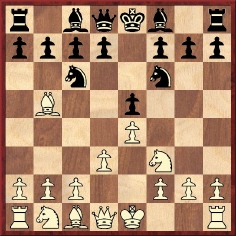
4...Ne7 5 Nxe5 c6 6 Nc4 cxb5 7 Nd6 mate. The miniature is, however, still frequently attributed to him, even today.
James Mortimer played 4...Ne7 on three occasions at London, 1883, the first being against Rosenthal on 7 May. Later in the event Zukertort essayed it against Englisch and wrote on page 22 of the tournament book, ‘Mr Mortimer claims to be the inventor of this move. I adopted it on account of its novelty’.
We note, though, that the following had appeared on page 147 of the April 1883 BCM:
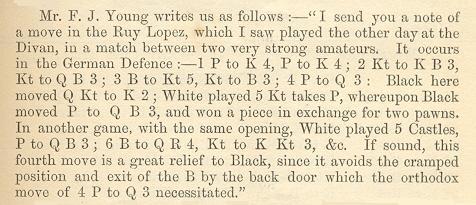
Was Mortimer one of the ‘two very strong amateurs’?
4...Ne7 was also played by C.E. Ranken against W.E. Vyse in the Vizayanagaram tournament at London, 1883 (Chess Player’s Chronicle, 24 October 1883, pages 166-167). For further information on Mortimer’s trap, see Bent Larsen’s article ‘So manchen wilden Pfad’ on pages 10-17 of Kaissiber, July-September 2005.
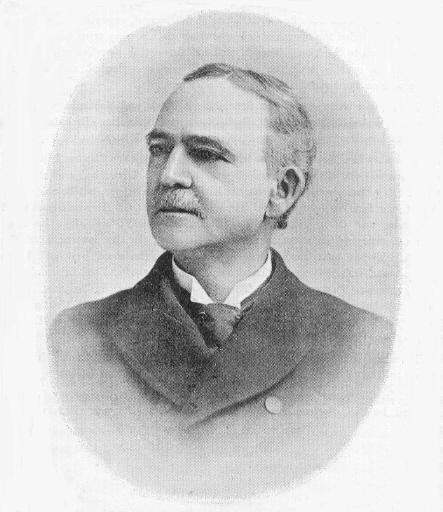
James Mortimer
(4845)
Information from British censuses provided by Joost van Winsen (Silvolde, the Netherlands):
1881 census: James Mortimer, age 47. Born in United States. Address: 39 Pembridge Villas (Kensington), London. Occupation: editor of London Figaro. Married with Lydia Mortimer (age 25, born in London). Children: L.M. Mortimer (daughter, age 6), Minnie E. Mortimer (daughter, age 4). Other household members: Kate Witney (age 16), servant (domestic); L. Witney (age 19), servant (domestic).
1891 census: James H. Mortimer, age 57. Born in United States of America. Address: 162 Regents Park Road (St Pancras), London. Occupation: author, dramatist and journalist. Married with Lydia Mortimer (age 34, born in London), act dramatic artist. Children: Lilian M. Mortimer (daughter, age 16), Minnie E. Mortimer (daughter, age 14). Other household members: Maria Stevens (age 16), general servant (domestic).

Page xii of The Treasury of Chess Lore by F. Reinfeld (New York, 1951)
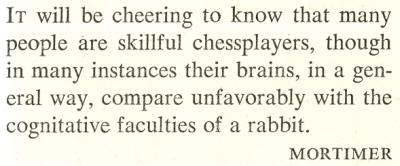
Page 15 of Chess Quotations from the Masters by H. Hunvald (Mount Vernon, 1972)
Above are just two examples of how ‘chess literature’ presents quotes. Not only is the source limited to a single word, ‘Mortimer’, but the texts differ. For instance, there is a choice between ‘cogitative’ and ‘cognitative’, and in this famous quote some websites offer a third option: ‘cognitive’.
We have therefore gone back to the original text, in an article by James Mortimer entitled ‘How to Win at Chess’ on page 9 of the Daily Mail, 6 October 1906:
‘To those who have taken up chess as an intellectual and fascinating pastime, and who are often beaten at odds by players of inferior grammar, it will be cheering to know that many persons are skilful chess players, though in some instances their brains, in a general way, compare unfavourably with the cogitative faculties of a rabbit. They are simply familiar with the openings – the well-beaten paths discovered or devised by the masters of the game.’
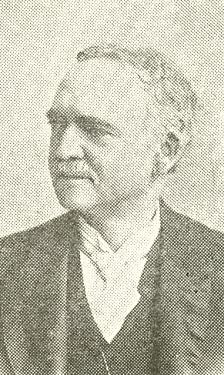
The above photograph of Mortimer was published on page 115 of The Rice Gambit by H. Keidanz (New York, 1905). For portraits of higher quality, see C.N.s 4845 and 4879.
(6122)
The complete Daily Mail article:
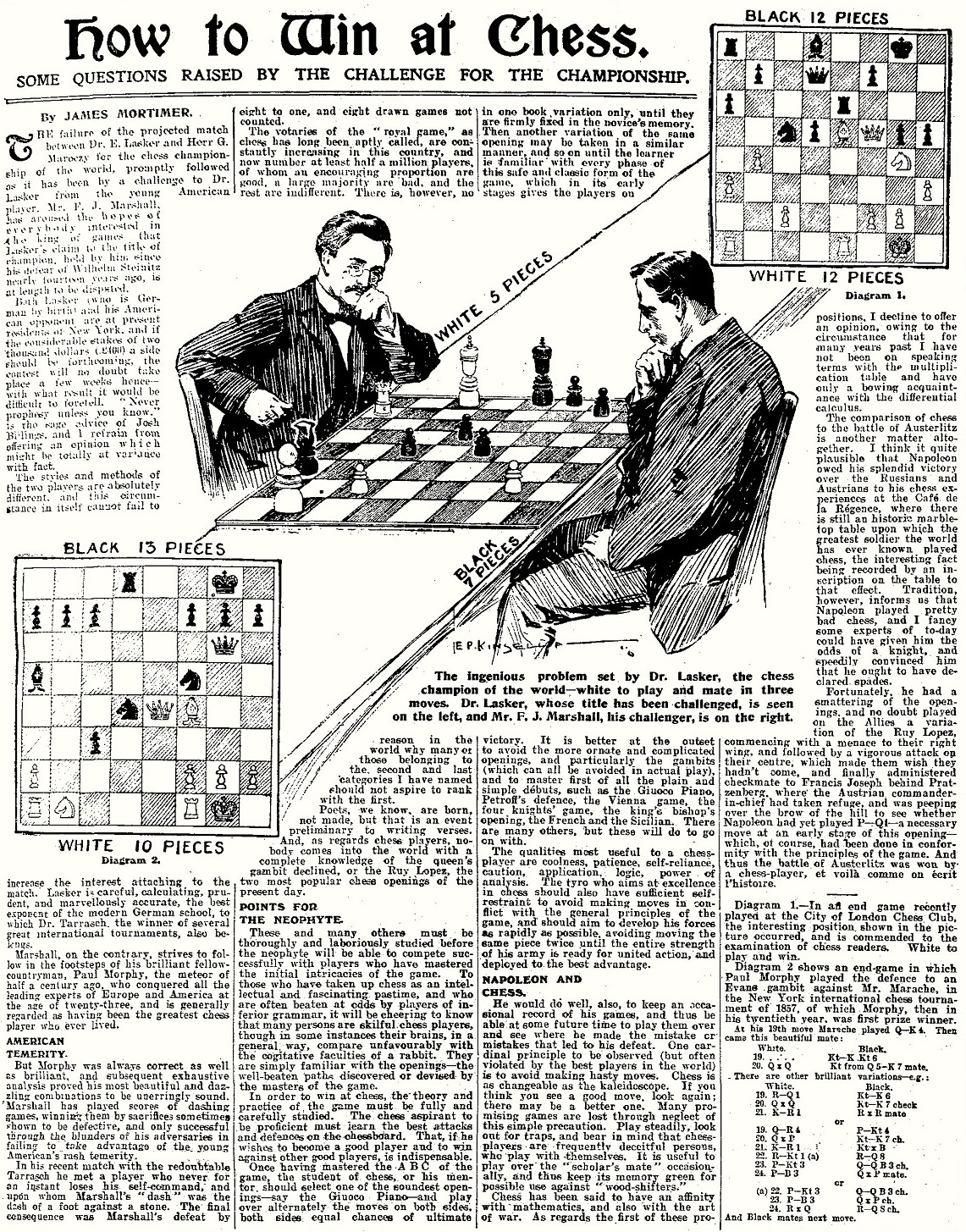
The ‘rabbit’ remark is in the second column of the article.
Following publication of the agreement signed by Lasker and Marshall on 26 October 1906 for a world championship match (see pages 147-148 of Lasker’s Chess Magazine, August-September 1906) James Mortimer quoted a few unhappy passages on page 8 of the Daily Mail, 5 December 1906 and commented:
‘All this is wonderfully weird. It may be very good Liskeranto or very elegant Marshallpuk, but it is certainly not very good English.’
(6123)
From Steinitz’s column in The Field, 7 February 1880, page 151:
‘We give the following game in illustration of the curious complications which arise at the odds of the “kept pawn”. This rare advantage was here given by Mr Mortimer, the inventor of the well-known Fraser-Mortimer variation of the Evans Gambit, and the game was played last month at Holloway Prison, where Mr Mortimer is now confined as a first-class misdemeanant, for having allowed a libel to appear in the Figaro, of which paper he is the proprietor. White gives the odds of the KBP coiffé, and undertakes to mate the adversary with that pawn without queening it.’
1 e3 e5 2 d3 d5 3 Nc3 c6 4 g3 Bd6 5 Nf3 Bg4 6 Bg2 e4 7 dxe4 dxe4 8 Nxe4 Bc7 9 Qxd8+ Bxd8 10 Nd6+ Kf8 11 Nxb7 Bb6 12 Nd6 Ne7 13 a4 Bxf3 14 Bxf3 Nd5 15 a5 Bc5 16 Nc4 Bb4+ 17 c3 Be7 18 O-O Nd7 19 Rd1 N7f6 20 Ne5 Rc8 21 c4 Nb4 22 Bd2 c5 23 Bc3 Nc2 24 Rac1 Nb4 25 Nd7+ Nxd7 26 Rxd7 Na2 27 Rc2 Nxc3 28 Rxc3 Bf6 29 Rb3 g6 30 Rbb7 Ke8 31 Rxf7 Bg5 32 Rxh7 Rxh7 33 Rxh7 Rd8 34 Rh8+ Ke7 35 Rxd8 Kxd8 36 Be4 Bf6 37 Bxg6 Bxb2 38 Be4 Kc7 39 Kf1 Bc3 40 a6 Kb6 41 Bb7 Ka5 42 Ke2 Kb4 43 Bd5 Ka5 44 Kd3 Be1 45 f3 Kxa6 46 g4 Bh4 47 f4 Kb6 48 Kc3 Bf6+ 49 Kb3 a5 50 g5 Bg7 51 h4 Ba1 52 h5 Bg7 53 h6 Bh8 54 g6 Bf6 55 g7 Bh4 56 g8(Q) Bf6 57 h7 Kc7 58 h8(R) Kd7 59 Rh7+ Kd6 60 Be4
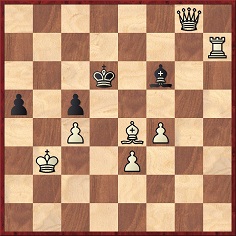
60...Be5 61 Qd8+ Ke6 62 f5 mate.
Black was identified only as ‘Mr B.’ by Steinitz, who annotated the game in depth. His term ‘kept pawn’ may well be an error for ‘capped pawn’.
(9250)
C.N.s 3366 and 3368 (given above and also reproduced on pages 218-220 of Chess Facts and Fables) presented parts of ‘Some Chess Players I Have Met’ by James Mortimer from pages 173-178 of the May 1905 BCM. On pages 293-297 of the August 1905 issue he contributed ‘Some More Chess Players I Have Met’.
Below is a profile of Mortimer by P.W. Sergeant on pages 155-160 of the April-September 1910 edition of the English Illustrated Magazine:
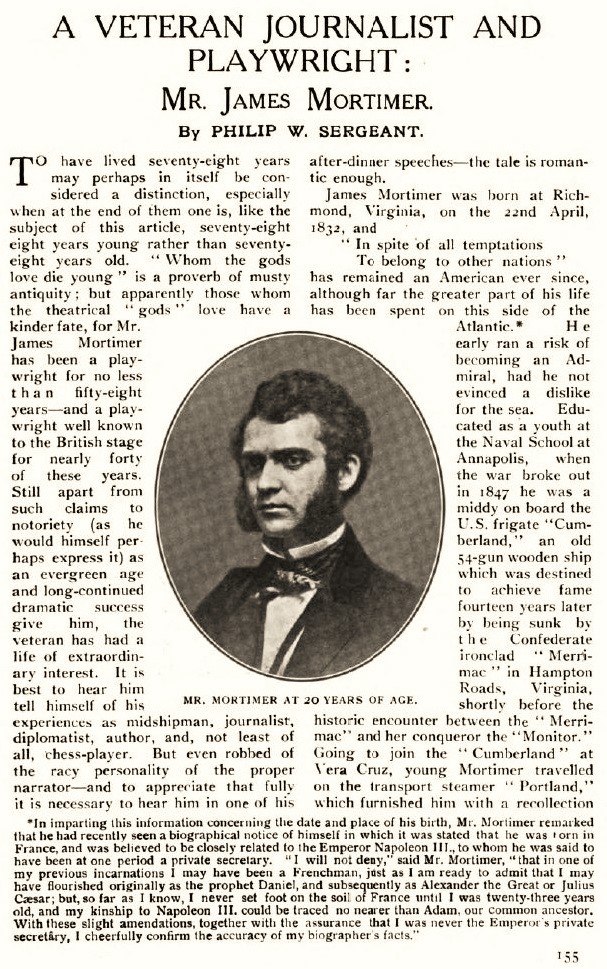
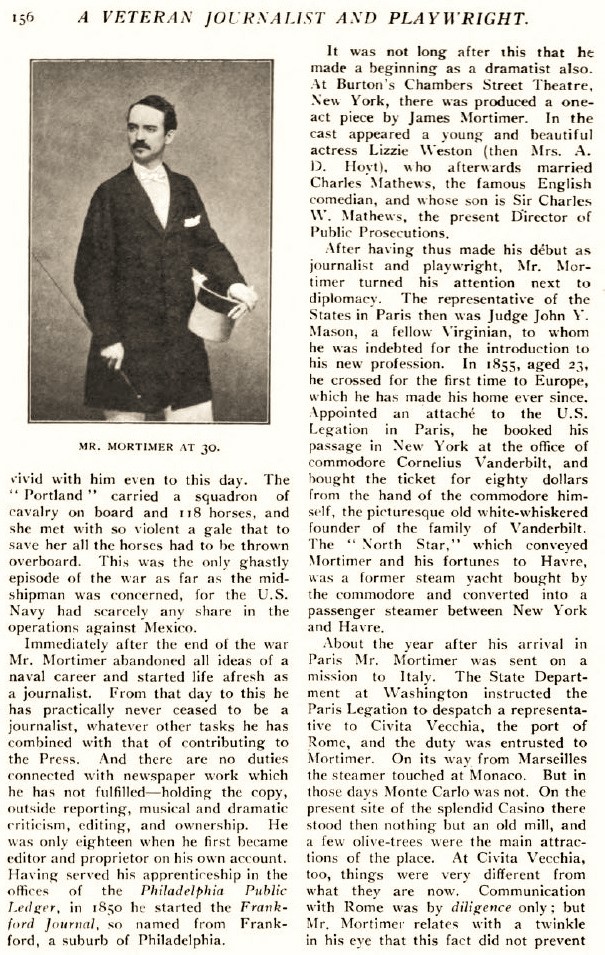
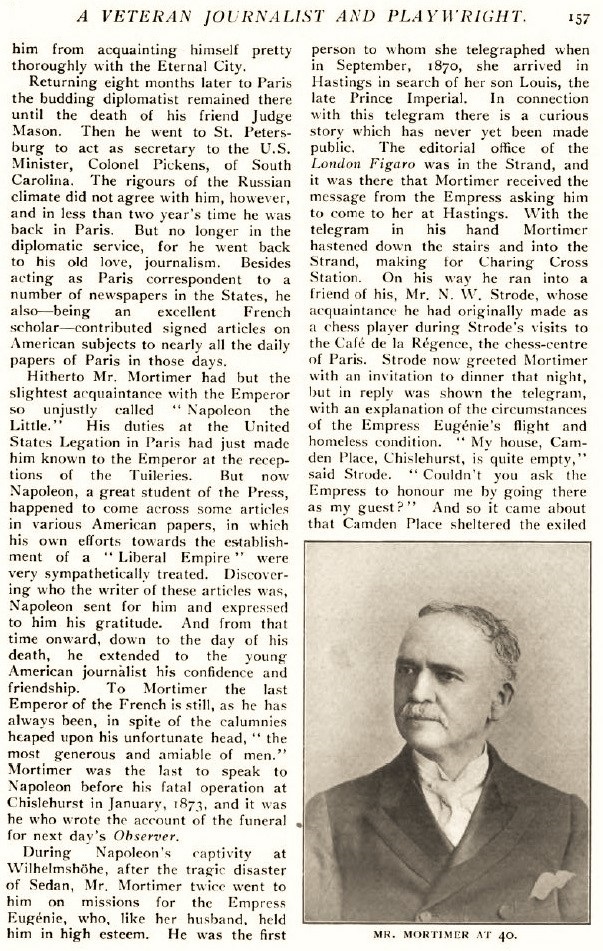
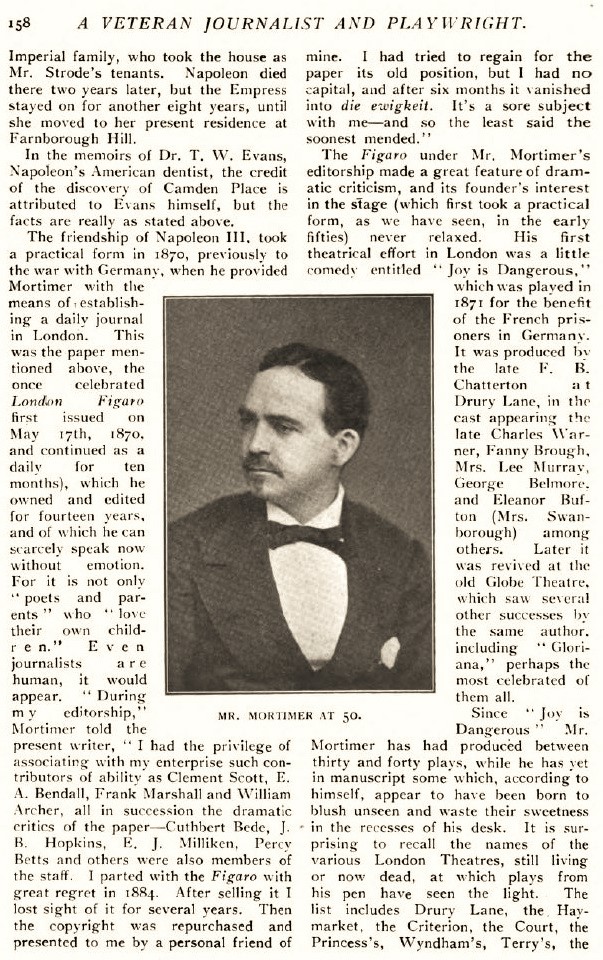
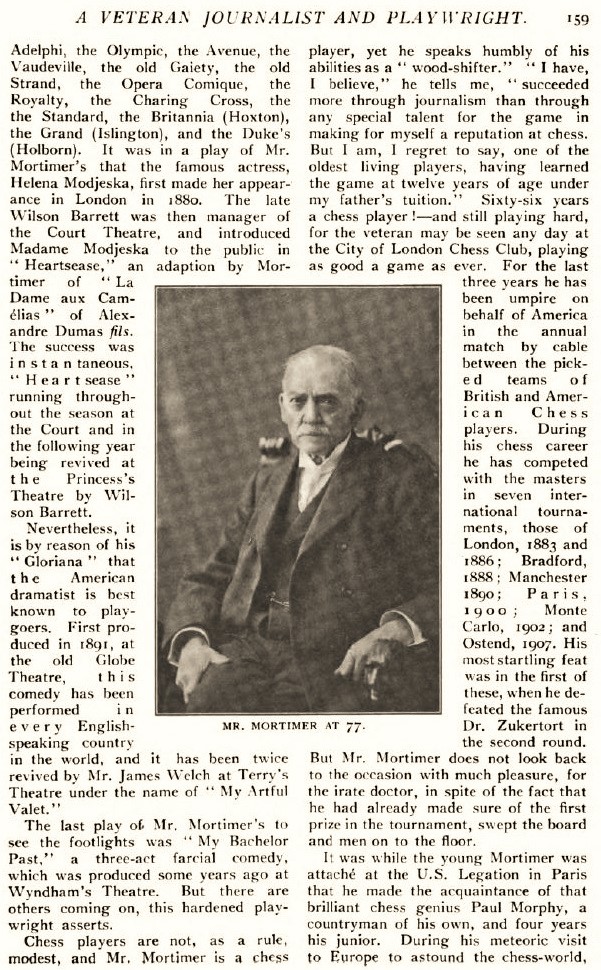
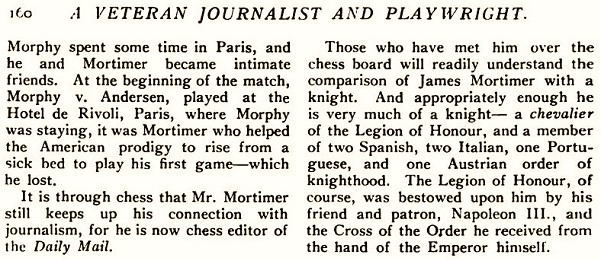
A number of points concerning Mortimer will be discussed in future items, including his year of birth (1832 or 1833?).
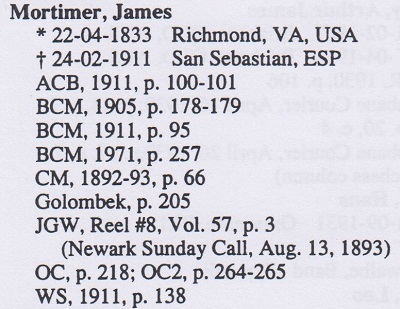
Chess Personalia by Jeremy Gaige (unpublished 1994 edition)
On page 155 of the English Illustrated Magazine, April-September 1910 (C.N. 11249), P.W. Sergeant wrote that James Mortimer was aged 78 at that time, having been born on 22 April 1832. A footnote on the same page stated that the information had been imparted by Mortimer himself. This would mean that when he died, in February 1911, he was aged 78.
Quite apart from secondary sources, primary ones offer much on Mortimer that is contradictory, and a non-exhaustive list follows.
Date of birth:
Date of death:
The BCM’s obituary was self-contradictory: if Mortimer was born on 22 April 1833 and died on 24 February 1911, he reached the age of 77, not 79. The oft-seen ‘aged 79’ cannot be correct in any eventuality.
In view of P.W. Sergeant’s comment about having corroboration from Mortimer himself, 22 April 1832 is by far the most likely birth-date, and particularly since it was also given on page 100 of the May 1911 American Chess Bulletin alongside this remark about a forthcoming international cable match:
‘In a recent letter to the Bulletin, Mr Mortimer wrote: “The second day of the match, 22 April, will be my 79th birthday, and I hope the boys will make me a present of an American victory on the day I enter upon my 80th year”.’
The full American Chess Bulletin obituary:
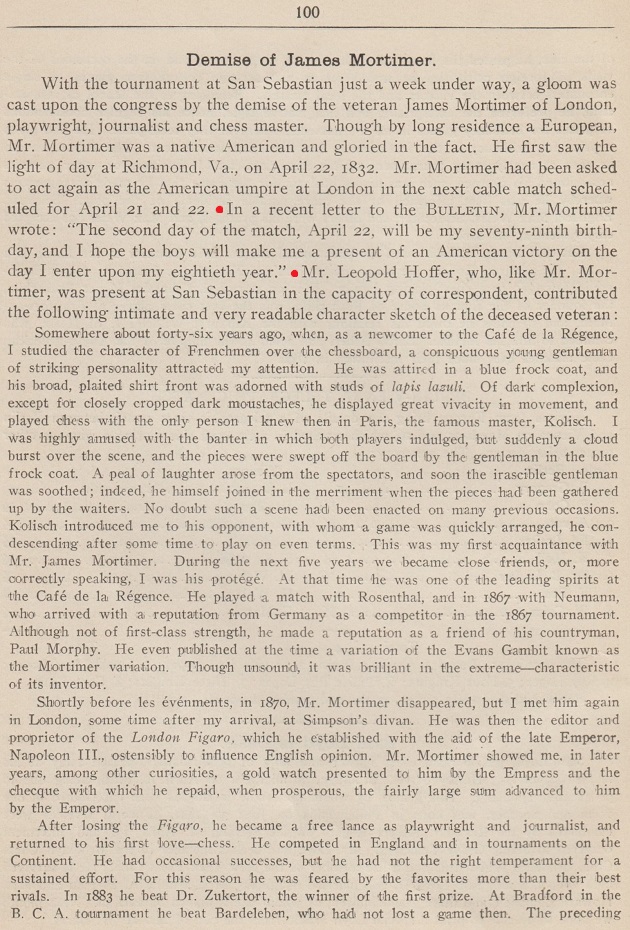
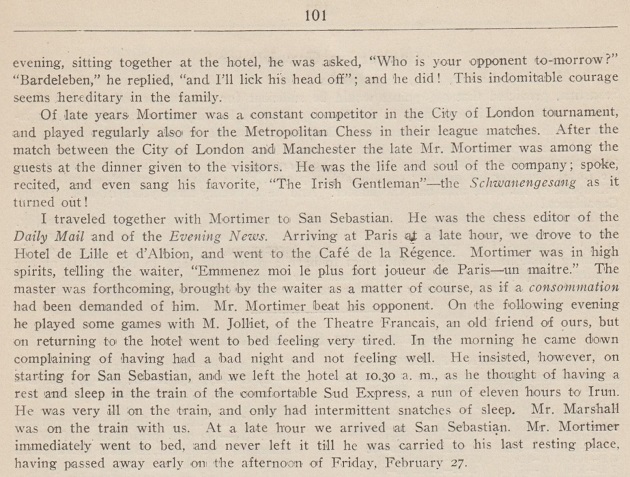
In the final line, the date is incorrect; the last Friday of the month was 24 February. The reference to ‘afternoon’ is contradicted by the above-mentioned obituaries in the Daily Mail and The Times.
Page 7 of the Daily Mail, 27 February 1911 reported that Mortimer’s funeral had taken place in San Sebastián on 25 February:
‘The chess masters now here sent a wreath with the inscription, “With deepest sympathy from the competitors in the San Sebastián Chess Tournament”.’
In the article by Mortimer quoted in C.N. 3366 above, he wrote, ‘I was Morphy’s fellow countryman, and four years his senior’.
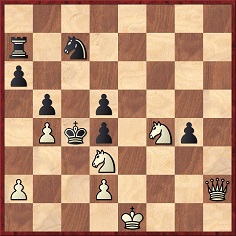
Mate in three
James Mortimer gave this problem in his chess column in the Daily Mail, 12 December 1906, page 8. When reproducing it on page 195 of the Chess Amateur, April 1911, P.H. Williams called it a composition which Mortimer ‘was never tired of showing to anybody who would look at it’.
Another comment on Mortimer by Williams in the same Chess Amateur article:
‘He composed a few problems, of the old-fashioned school, but his knowledge of modern problem construction was quite rudimentary, though he probably would never have admitted it.’
Below is the problem as published in James Mortimer’s chess column in the Daily Mail, 12 December 1906, page 8:
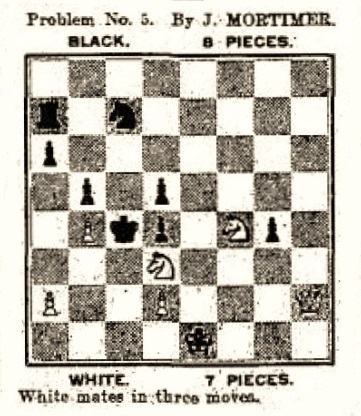
Michael McDowell (Westcliff-on-sea, England) reports that it is the only composition by Mortimer in the WinChloe database, where the original source specified is the periodical Knowledge. That was in C.D. Locock’s column on page 99 of the 1 May 1891 edition:
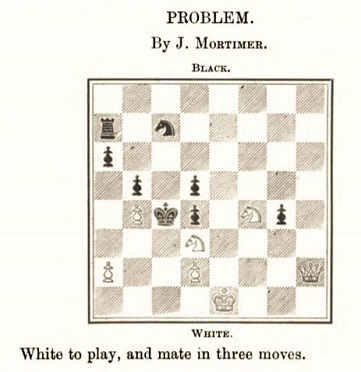
The first of the reproductions listed in the WinChloe database is page 288 of the September 1891 International Chess Magazine. We note that Steinitz’s periodical gave as its source the Hereford Times, without a date.
(11253)
James Mortimer’s introductory comments in his article ‘Some More Chess Players I Have Met’ on pages 291-297 of the August 1905 BCM:
‘... I now realize that the historian can assert anything he likes about the dim and distant past, but, in writing of the present, is obliged to stick to the simple and beautiful truth. De mortuis nil nisi bonum is a maxim frequently ignored, when you are telling a tale about a Mr de Mortuis who is permanently mortuised, and not in a position to look after you with a big stick, or to commence an action for libel against your publisher. This is a source of great comfort, and you give your mortuis plenty, with a lofty contempt of the consequences.
But when you tackle Mr de Vivis, etc., it is a totally different pair of boots, especially if they happen to be large, thick, hob-nailed, aggressive, fatal, lethal boots. How, then, am I to say what I think of living chess players, without giving rise to a trial of physical strength in which, of course, I should be top dog, but I should nevertheless deplore, as a member of the Society for the Prevention of Cruelty to Animals? Everybody knows that the genus irritabile vatum is of a positively angelic temper, compared with the genus irritabile chess player. I have met chess players whom I have heard others praise, and that highly – not to speak it profanely – for their gentle ways and winning politeness. But I have noticed that these same lamb-like woodshifters are not usually endowed in the same degree with losing politeness, and plainly show their antipathy to being beaten across the board.’
Christian Sánchez (Rosario, Argentina) has forwarded two puzzling cuttings:
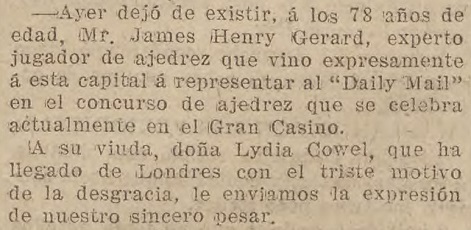
El Pueblo Vasco (San Sebastián), 25 February 1911, page 1
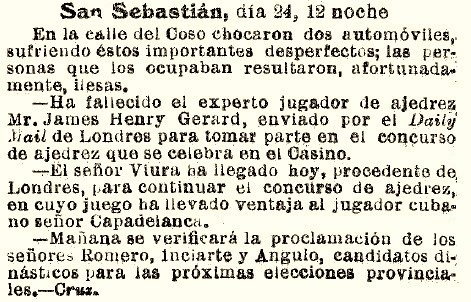
La Vanguardia (Barcelona), 25 February 1911, page 8
We can offer no explanation as to why the Daily Mail’s deceased chess correspondent was identified as James Henry Gerard. His widow was named by El Pueblo Vasco as Lydia Cowel; an Internet search for James Mortimer yields a number of pages which also mention Lydia Cowell in connection with theatrical activities.
(11256)
Javier Asturiano Molina (Murcia, Spain) reports that he has found Mortimer’s death certificate, dated 24 February 1911, in the Registro Civil of San Sebastián:
‘... D. James Enrique Gerardo Mortimer, natural de Virginia (Estados Unidos de América), de setenta y ocho años de edad, periodista, domiciliado accidentalmente en esta Capital, Calle de Zubieta, Hotel de Londres, ha fallecido á las dos y media de hoy, en el referido domicilio, á consecuencia de bronco pneumonía.’
The certificate was signed by the juez municipal the same day (‘á las diez y seis del día veinticuatro de Febrero de mil novecientos once’).
(11264)
The curious conclusion of the game Dunstan v Mortimer, Plymouth, 1903 was given by us in Kingpin, 1999 (and on page 28 of A Chess Omnibus), under the heading ‘Queen marooned’:
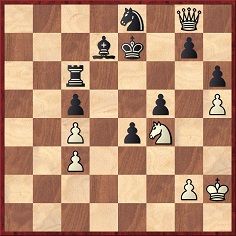
D. Dunstan-J. Mortimer, Plymouth (Southern Counties Congress), August 1903
Play went: 47 Ng6+ Rxg6 48 hxg6 Be6 49 Qh7 f4 50 Kg1 Bxc4 51 Kf2 Kf8 52 Qh8+ Bg8 53 g4 fxg3+ 54 Kxg3 Nf6 55 Kf4 e3 56 Kxe3 Nd5+ 57 Ke4 Ne7 58 Qh7 Bxh7 59 gxh7 Ng6 60 Kd5 Nh8 61 Kxc5 g5 and Black won.
Source: Revue d’échecs, January 1904, page 108.
For coverage of the Mortimer v Rosenthal match, Paris, 1867, see C.N. 3365 (pages 59-61 of Chess Facts and Fables and The Mortimer v Rosenthal Match).
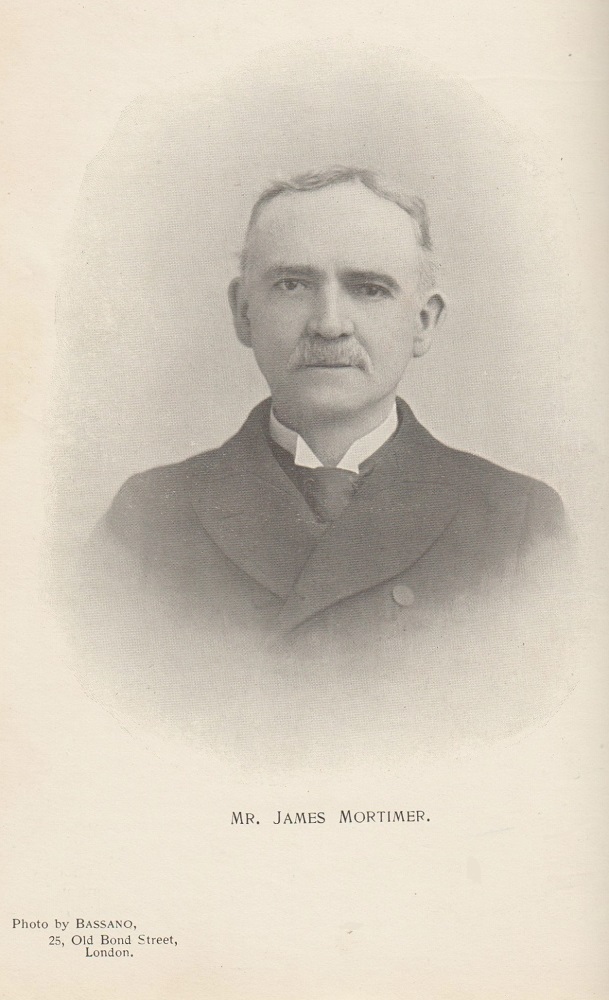
Frontispiece, BCM, May 1905.
From our feature article Chess Photographs in the Daily Mirror:
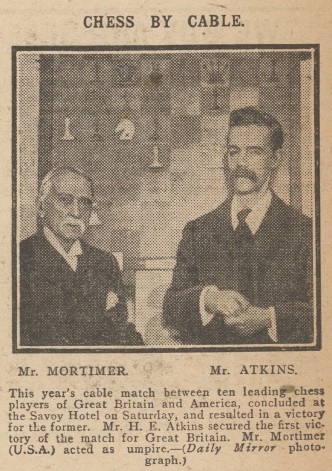
14 March 1910, page 5
See too the references to Mortimer in our feature article on Zukertort.
To the Chess Notes main page.
To the Archives for other feature articles.
Copyright: Edward Winter. All rights reserved.